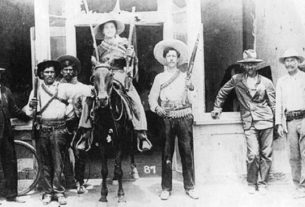A Balloon in Cactus
There was a time in history when Mexico was accused by a U.S. NAFTA-opposed politician of making “giant sucking sounds.” Well, folks, the giant noises coming from Mexico today are not giant sucking sounds, they are giant rumbling sounds, and they’re coming from the Mexican Army convoy driving north to help the U.S. in its time of crisis.
As water rises over the rooftops of New Orleans, the Mexican Army prepares to do battle on behalf of their neighbors to the north. Geographically, Mexico is one of the few places that Mississippi and Louisiana are not south of.
For the first time since 1846, Mexican military units will operate on U.S. soil, as Mexican Army trucks and tractor trailers convoy north, with Mexican flags taped to the roof tops of the 45 vehicles.
These vehicles, manned by 200 soldiers, officers and specialists, carry water treatment plants, mobile kitchens and supplies to feed the victims of Hurricane Katrina.
The convoy includes military engineers, doctors, nurses, two mobile kitchens that can feed 7,000 people each per day, three flatbed trucks carrying mobile water treatment plants, and 15 trailers of bottled water, blankets and applesauce. Burritos on the side.
Last time Mexican troops were on U.S. soil (1846), they advanced north of the Rio Grande in Texas, which had recently joined the United States. Mexico, however, did not then recognize the Rio Grande as the U.S. border. There are those who say it still doesn’t.
In 1916, Pancho Villa led a group of fighters in a brief raid into Columbus, New Mexico, in what is considered the last battle against foreign forces on U.S. soil. Apparently, nobody is counting Taliban terrorist cells in the U.S.
Mexico is a way good neighbor. Back in World War II, it sent a squadron of pilots to train in the United States, and they fought side-by-side with the U.S. Air Force in the Philippines. Many U.S. citizens are not aware that Mexico also declared war on the bad guys in WWII.
As of this writing, Mexico was planning another 12-vehicle aid convoy to leave Tuesday or Wednesday and already has a Mexican navy ship steaming toward the Mississippi coast with rescue vehicles and helicopters.
Foreign Secretary Luis Ernesto Derbez said Mexico is setting up consular offices in trailers around the disaster zone to help some of the estimated 140,000 Mexicans who live in the region, 10,000 of them in New Orleans. Those men were probably the brass section of a Dixieland Jazz band.
In addition, help was offered by a search-and-rescue group called “topos” — (moles) — organized by youths who dug through collapsed buildings after Mexico City’s 1985 earthquake.
“This is just an act of solidarity between two peoples who are brothers,” Fox’s spokesman Ruben Aguilar said of the mission.
“This is the first time that the United States has accepted a military mission from Mexico” for such work, said Javier Ibarrola, a newspaper columnist who covers military affairs in Mexico. “This is something that’s never happened before.”
The relief mission was controversial for some Mexican senators, who said President Fox should have sought Senate approval for sending troops. U.S. citizens are just glad Mexico has a president strong enough to give an order without wading through red tape.
Sounds like disasters are handled better by countries without politicians.
Mexico has sent disaster relief aid missions to other Latin American nations, but never before to the United States.
In the words of the New Orleans flood survivor who was helping reunite lost children with their parents, “When you help someone else out, you help the world.”
Mexico puts its people where its mouth is.


